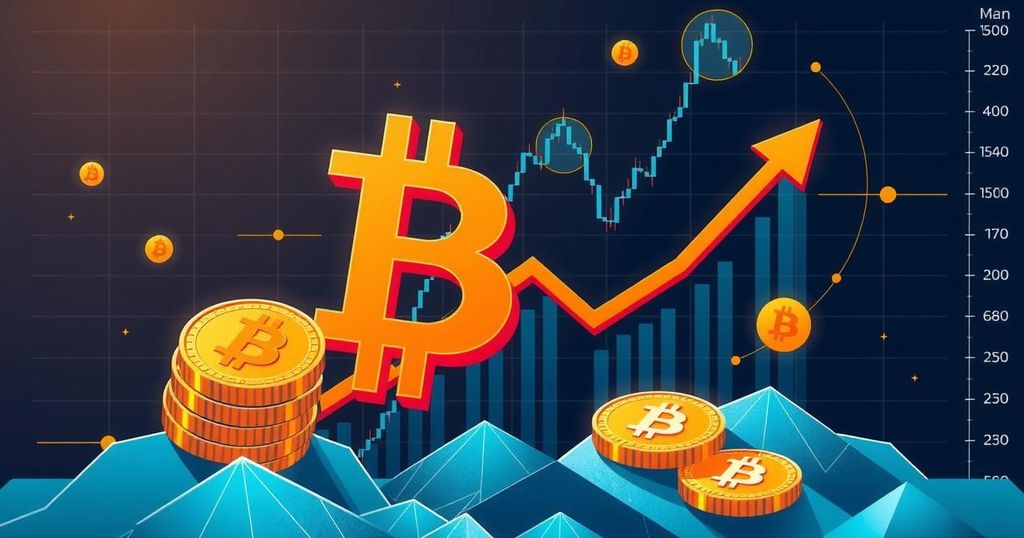The Impact of the Federal Reserve’s Inflation Rate on Bitcoin and Cryptocurrency Markets
In September 2023, the Fed’s inflation rate hit 2.1%, closely aligning with their target, leading to a decline in Bitcoin’s value to $69,263.81 amid profit-taking. The rise in core inflation to 2.7% raises concerns as the Fed anticipates further interest rate cuts in upcoming meetings. The implications of these developments significantly affect the cryptocurrency market, reflecting investor sentiment amidst evolving economic expectations.
In September 2023, the Federal Reserve’s inflation rate reached 2.1%, approaching the central bank’s target of 2%. This development led to a decline in Bitcoin’s value, which fell to $69,263.81 amid profit-taking following a recent spike in its price. The Commerce Department reported on October 31 that the personal consumption expenditures (PCE) price index had risen by 0.2% for the month on a seasonally adjusted basis, which aligns with the Dow Jones projections, indicating a steady movement toward the Fed’s inflation objectives. Since February 2021, the Fed has been striving to stabilize inflation at 2%. Core inflation, however, remains a concern, currently recorded at 2.7%, a 0.3% increase from the previous month. Such trends are significant as they guide the Federal Reserve’s policy decisions. Moreover, the core PCE index for September was recorded at 0.3% month-on-month, matching expectations and signifying the largest monthly increase since April. The ensuing anticipation in the markets suggests potential adjustments in the short-term borrowing rate at the upcoming Federal Reserve meeting. The release of this key inflation data has engendered profit-taking tendencies within the cryptocurrency market, particularly impacting Bitcoin, which had rallied to $73,000 before retreating to $69,263.81, reflecting a 4.58% decrease over a 24-hour period. The decline was not isolated to Bitcoin; the global cryptocurrency market capitalization also shrank by 1.75% to $2.33 trillion. Though Bitcoin had witnessed a significant decline in 2022, plummeting below $20,000 amid concerns over the Fed’s interest rate hikes, it gained momentum in 2023, registering a 1% increase post-FOMC meetings. With the Federal Reserve poised for its upcoming meeting, there is growing speculation about further rate reductions, following a half-percentage point cut in September. The Fed anticipates adjusting the rate to 4.75% to 5.00%, with potential quarter-point reductions expected in November and December. Looking ahead, the Fed’s target policy rate stands at 3.4% by the end of 2025, with ambitions to maintain stability at 2.9% throughout 2026 and 2027. This reflects a careful approach to establishing a neutral interest rate amidst economic challenges.
The Federal Reserve plays a critical role in managing the economy through its monetary policy and inflation targets. The inflation rate, particularly the personal consumption expenditures (PCE) price index, is a key indicator used by the Fed to shape its interest rate policies. Maintaining an annual inflation rate of 2% is essential for economic stability, reflecting the Fed’s policy objectives. As inflation forecasts rise or fall, they can significantly influence market behavior across various sectors, including cryptocurrencies such as Bitcoin. The interplay between the Fed’s policy decisions and market responses underlines the importance of economic indicators in forming expectations about interest rates and their impact on asset prices.
In summary, the Federal Reserve’s inflation rate reaching 2.1% has had a notable impact onBitcoin and the broader cryptocurrency market, leading to a decline following recent highs. While core inflation remains a significant concern, market expectations are leaning towards potential rate reductions in the near future. Understanding these dynamics is crucial for investors as they navigate the implications of Fed policies on cryptocurrency valuations.
Original Source: ambcrypto.com




Post Comment